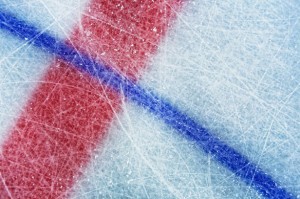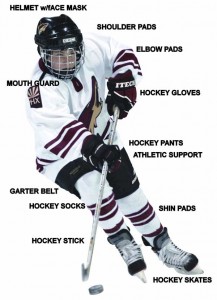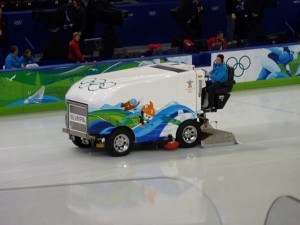Although born in Canada, I spent the formative childhood years in the United States at a time and place in which hockey was not something many people played and followed.
the formative childhood years in the United States at a time and place in which hockey was not something many people played and followed.
I never really followed the game much until my nine-year-old stepdaughter, Meaggie, started playing Novice level hockey in our hometown of Lantz, Nova Scotia. Suddenly I was thrust into the midst of a sport about which I knew very little. Attending her first game sort of felt like attending my first neuro-anatomy lecture. In both cases I felt totally lost!
I decided to make a concerted effort to demystify the game. After all, I finally did manage to figure out neuro-anatomy, so how hard could hockey be?
My first step was to purchase the book HOCKEY FOR DUMMIES. After all, Mark Messier says right on the front cover, “…Hockey for Dummies will turn you into one” — and he should know what he’s talking about. (Okay, I deserve a two-minute penalty for quoting out of context from John Davidson’s excellent book).
Why is Hockey, Hockey?
 First of all, the word “HOCKEY” apparently derives from the French word “hoquet” or “bent stick” (not to be confused with the Yiddish, “twisted shtick”). Its first North American appearance was in Nova Scotia, where freezing soldiers, running out of rum to stay warm, hit upon the idea of skating about like madmen on frozen bodies of water flailing sticks at each other in order to raise body temperature.
First of all, the word “HOCKEY” apparently derives from the French word “hoquet” or “bent stick” (not to be confused with the Yiddish, “twisted shtick”). Its first North American appearance was in Nova Scotia, where freezing soldiers, running out of rum to stay warm, hit upon the idea of skating about like madmen on frozen bodies of water flailing sticks at each other in order to raise body temperature.
This apparently struck a chord across the country and soon freezing Canadians everywhere were getting into the act. In 1892, Lord Stanley, impressed with the game, donated a huge and rather ugly trophy known as THE STANLEY CUP, which became the Holy Grail of hockey.
With this vital historical information I was ready for my first encounter with Novice Hockey, starting in the locker room. Donning hockey gear makes scrubbing for the Operating Room look like child’s play. Apparently one of the most vital pieces of equipment is the HOCKEY CUP (or “hockey mug” as Meaghan once called it). Please note that while THE STANLEY CUP is technically a “hockey cup,” it should never be worn, though no doubt some have tried.
Other pieces of gear i nclude various pads, garter belts, hose and assorted paraphernalia, like something from twisted Victoria’s Secrets catalog for heavy steroid users. Power point: tie your kid’s laces real tight or the child will look like they need the attention a good orthopedic surgeon out on the ice.
nclude various pads, garter belts, hose and assorted paraphernalia, like something from twisted Victoria’s Secrets catalog for heavy steroid users. Power point: tie your kid’s laces real tight or the child will look like they need the attention a good orthopedic surgeon out on the ice.
Next, after taking my seat in the stands, I harnessed my keen powers of observation to absorb as much practical information as possible about the game. Here are the fruits of my labors.
Zambonis, Pucks and Wings
My first observation was that the most important man in the rink drives a vehicle with a name like an Italian dessert — the Zamboni. Before the game begins this gent resurfaces the scarred and pitted ice to pristine smoothness in a way that which would be the envy of any cosmetic surgeon. I also noticed that the playing arena or RINK is decorated with lovely BLUE and RED LINES, five attractive circles and two semi-circles. Although this gives the RINK a festive look, I later found that there were functional uses for these markings as well. Oh yes, the RINK is covered with ICE.
At any one time there are supposed to be six players on each team. One fellow, who appears to be more heavily armored than his teammates, stays in the CREASE, or semi-circle in front of the net. He or she is constantly bombarded with a hard rubber disk called a PUCK (apparently not named for the elf in A Midsummer Night’s Dream, though both fly and are capable of causing a lot damage).
In Novice hockey, the GOALIE’S job is to strike imaginative and entertaining poses, while allowing the PUCK to pass between her legs, under her arms or bounce off various portions of her anatomy before it enters the net. She is also equipped with a stick larger than that of his teammates, which she uses to keep from falling down and with which she occasionally and apparently unintentionally blocks the PUCK from entering the net.
 Of the remaining five players two are designated as DEFENSE and theoretically are supposed to prevent the opposing team members from getting too close to the GOALIE. There are three players who are designated as OFFENSIVE, though frankly I did not find their behavior any worse than that of any one else on the ice. One is called RIGHT WING and the other LEFT WING. The CENTER stands between these two, presumably to settle any political differences in an amicable manner so that everyone can get on with the game.
Of the remaining five players two are designated as DEFENSE and theoretically are supposed to prevent the opposing team members from getting too close to the GOALIE. There are three players who are designated as OFFENSIVE, though frankly I did not find their behavior any worse than that of any one else on the ice. One is called RIGHT WING and the other LEFT WING. The CENTER stands between these two, presumably to settle any political differences in an amicable manner so that everyone can get on with the game.
Getting Onside with “Offside”
Hockey has a vocabulary as esoteric as that of medicine. Unfortunately, Latin 100 class will not allow you to figure out the meaning of these terms as they appear in deceptively plain English. Don’t be fooled. When they called someone for ICING the first time I kept wondering where the cake was. When I finally realized there was no cake I still couldn’t figure why they kept blowing the whistle every time a puck was fired down the rink toward the opposing side. Wasn’t this the reason they were playing in the first place? After the whistle blew they had something called a FACE-OFF. Despite the name, all the players’ faces appeared to remain firmly attached.
OFFSIDES was another term that baffled me for a while. As close as I can figure out, the REFEREE (that’s the guy in the striped pajamas) just waits until one team gets a good run on the opposition’s goal, then maliciously blows his whistle and spoils all the fun, making everyone go back and do another FACE-OFF.
It’s the Penalty Box for You
 PENALTIES, at least at the Novice Level, were rarely called. Just to clarify one thing, if your daughter is called for HOOKING, don’t panic. It simply means she slowed another player down by “hooking” her stick around them. Though one may see TRIPPING, SLASHING, SPEARING and other horrific forms of behavior, at the Novice level it appears to be mostly unintentional and aimed at self or fellow teammates as often as the opposition. Later on, players tend to direct these activities more towards opposing team members.
PENALTIES, at least at the Novice Level, were rarely called. Just to clarify one thing, if your daughter is called for HOOKING, don’t panic. It simply means she slowed another player down by “hooking” her stick around them. Though one may see TRIPPING, SLASHING, SPEARING and other horrific forms of behavior, at the Novice level it appears to be mostly unintentional and aimed at self or fellow teammates as often as the opposition. Later on, players tend to direct these activities more towards opposing team members.
If called for a PENALTY, the player is made to sit in a PENALTY BOX. This is a bit like a “time out” for being naughty and the length of time in the PENALTY BOX depends on exactly how naughty you’ve been. Parents in the stands often take issue with the REFEREE or LINESMAN’S decisions in this regard. From parental comments I was touched to learn that most of these officials are hired as part of a pro-active employment program for the perceptually challenged.
At the end of the game each team appears to vent their accumulated frustrations by pelting their GOALIE with blows and bear hugs, then line up and wish their opponents well. Often an MVP is named (Most Vituperative Parent?) Then everyone goes Tim Horton’s and has hot chocolate.
So there you have the fine points of Novice Hockey in a nutshell (a term also synonymous with “hockey mug” I believe). Armed with this information, even the rankest tyro should be able to razz the referee in a knowledgeable and informed manner at their next hockey game.
Photo Credits
“Hockey Ice” courtesy of cbc.ca
Hockey for Dummies by John Davidson
“Hockey Equipment” courtesy of www.puckbrain.com
“Olympic Zamboni” Photographer Unknown


[…] This post was mentioned on Twitter by Dan L Hays, Life As A Human. Life As A Human said: New Article, On Thin Ice (or Hockey for Dummies Made Even Easier) – http://tinyurl.com/2ckxemj […]